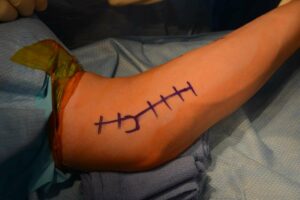Tommy John’s pain isn’t just a term familiar to baseball pitchers. In fact, it’s a growing concern for athletes in various sports. Named after the first baseball player to undergo a groundbreaking surgical procedure, this type of pain refers to the injury of the ulnar collateral ligament (UCL) in the elbow. Understanding the symptoms, causes, and treatments of Tommy John’s pain is essential for athletes, coaches, and healthcare providers alike. This comprehensive guide will dive into the world of Tommy John’s pain, offering insights and solutions to keep athletes in the game.
Contents
What is Tommy John’s Pain?
 Tommy John Pain refers to a specific type of elbow injury that affects the ulnar collateral ligament (UCL). It is a vital ligament that connects the humerus to the ulna. Named after Tommy John, a Major League Baseball pitcher who was the first to undergo surgery to repair this ligament. This term has come to symbolize both the injury itself and the surgical procedure used to correct it. The UCL can become stretched, frayed, or torn through the repetitive stress of overhead motions. Particularly those common in various throwing sports.
Tommy John Pain refers to a specific type of elbow injury that affects the ulnar collateral ligament (UCL). It is a vital ligament that connects the humerus to the ulna. Named after Tommy John, a Major League Baseball pitcher who was the first to undergo surgery to repair this ligament. This term has come to symbolize both the injury itself and the surgical procedure used to correct it. The UCL can become stretched, frayed, or torn through the repetitive stress of overhead motions. Particularly those common in various throwing sports.
The injury is most commonly associated with baseball players, especially pitchers. But it can affect athletes in other sports involving similar arm movements. The term encapsulates the discomfort, loss of function, and the often arduous journey toward recovery from this specific type of elbow injury.
What Are The Symptoms To Look For?
The symptoms of Tommy John’s pain, or UCL injury, are often progressive. And starting subtly and becoming more pronounced as the ligament becomes more damaged. Key symptoms to look for include:
- Pain Inside the Elbow
This is often the first and most noticeable sign, especially during or after an activity that involves throwing or overhead motions. The pain might subside with rest but often returns with resumed activity.
- Swelling and Inflammation
The affected elbow might swell, becoming tender to the touch. Inflammation can be a sign of irritation in the ligament.
- Decreased Performance
Athletes may notice a decrease in their ability to throw or perform overhead movements with the same power or accuracy as before. A loss of strength or endurance in the affected arm might also occur.
- Stiffness or Instability
The elbow may feel stiff or unstable, particularly during specific movements. This can further restrict the range of motion and make certain activities uncomfortable or challenging.
- A “Pop” or Tearing Sensation
In some cases, particularly if the ligament is severely damaged, there may be a sensation of tearing or a “pop” in the elbow at the time of injury.
- Numbness or Tingling
Sometimes, irritation or damage to the UCL can cause numbness or tingling in the forearm or fingers, signaling potential nerve involvement.
It’s essential to recognize that these symptoms might not always be present or obvious, especially in the early stages of the injury. Consulting with a healthcare provider who specializes in sports medicine, can lead to an accurate diagnosis and appropriate treatment plan.
What Causes Tommy Johns?
 The causes of Tommy John’s pain, or UCL injury, are multifactorial and often relate to repetitive stress and overuse. Here’s an overview of the common causes:
The causes of Tommy John’s pain, or UCL injury, are multifactorial and often relate to repetitive stress and overuse. Here’s an overview of the common causes:
1. Repetitive Throwing or Overhead Movements
Sports like baseball, softball, tennis, and volleyball require continuous and forceful overhead actions. The repetitive strain can lead to microscopic tears in the ligament. Eventually causing it to become stretched, frayed, or torn.
2. Poor Technique or Mechanics
Incorrect throwing or movement techniques can place undue stress on the UCL, making it more susceptible to injury. Coaches and athletes need to pay close attention to proper form and mechanics to minimize this risk.
3. Overuse Without Adequate Rest
Lack of proper rest between performances, practices, or games can contribute to wear and tear on the ligament. The body requires time to heal and recover. And constant activity without adequate rest can lead to injury.
4. Previous Injuries or Weakness in the Area
If an athlete has had previous injuries to the elbow or surrounding structures. Or if there is an inherent weakness in the muscles and ligaments of the arm, they may be more prone to UCL injury.
5. Growth Plate Issues in Young Athletes
Adolescents and young athletes who are still growing might have growth plates that are more susceptible to injury. This vulnerability can increase the risk of damage to the UCL and other structures in the elbow.
6. Increased Velocity and Intensity
Athletes are continually trying to increase the speed and force of their throws without proper conditioning. And preparation may put extra strain on the UCL.
7. Using Inappropriate Equipment
Using equipment that is not suited to the athlete’s body, skill level, or specific sport can also contribute to the risk of injury. This might include using a baseball that’s too heavy or a racket that’s not the right size.
Understanding these causes can help in developing appropriate prevention and training strategies. By focusing on proper technique, adequate rest, and targeted strengthening and flexibility exercises, athletes and coaches can work together to reduce the risk of Tommy John’s pain.
How Do You Relieve Tommy John’s Pain?
Relieving Tommy John’s pain requires a careful approach that often includes a combination of rest, rehabilitation, and professional medical care. Here’s how the pain might be managed:
- Rest: Taking a break from the offending activity allows the ligament to start healing. Continuous strain will only exacerbate the problem.
- Immobilization: Using a brace or splint can keep the elbow in a stable position, preventing further strain or injury. This is often done under the supervision of a medical professional.
- Ice: Cold therapy helps to constrict blood vessels, reducing swelling, and providing relief from pain. Applying ice in intervals (e.g., 20 minutes on, 40 minutes off) is a common practice.
- Compression: Wrapping the affected area with a bandage can limit swelling and provide support to the injured tissues.
- Therapy: Customized programs focusing on strengthening and stretching exercises help restore function, improve mobility, and prevent re-injury.
- Modalities: Techniques such as ultrasound or electrical stimulation might be used to promote healing and reduce discomfort.
- NSAIDs: Medications like ibuprofen can help control inflammation and pain. Usage should be as directed by a healthcare provider, considering potential side effects.
- Technique Training: Working with coaches or therapists to ensure proper throwing or movement mechanics can prevent further injury.
- Tommy John Surgery: For severe or chronic cases, surgery to replace the damaged ligament might be necessary. This is followed by an extended period of rehabilitation, often lasting a year or more.
- Injections: These anti-inflammatory injections are typically considered when other treatments fail. They must be administered by healthcare professionals, as frequent use can lead to further joint damage
- Specialized Braces: These devices are designed to reduce stress on the UCL and may be used during recovery or as a preventive measure during activity.
Consulting with a Specialist:
Other Preventive Measures
- Warm-up and Cool-down: Implementing proper warm-up and cool-down routines prepares the muscles and ligaments for activity and aids recovery.
- Strengthening Exercises: Targeted exercises can strengthen the muscles around the elbow, reducing stress on the ligament.
- Throwing Guidelines: Adhering to guidelines regarding throwing counts, rest days, and monitoring fatigue can prevent overuse and strain on the elbow.
The multifaceted approach to relieving Tommy John’s pain recognizes that each individual’s situation might require different strategies. Coordinated care involving various healthcare professionals ensures that the treatment is comprehensive and targeted. This addresses not only the symptoms but also the underlying causes, thereby promoting a full and lasting recovery.
Can Tommy John Injury Heal On Its Own?
 A Tommy John injury, or an injury to the ulnar collateral ligament (UCL) in the elbow, can vary in severity, and the potential for self-healing depends on the extent of the damage. Mild strains or microscopic tears might heal on their own with proper rest, immobilization, and careful management. In these cases, taking a break from the activities that caused the strain may allow the ligament to heal naturally.
A Tommy John injury, or an injury to the ulnar collateral ligament (UCL) in the elbow, can vary in severity, and the potential for self-healing depends on the extent of the damage. Mild strains or microscopic tears might heal on their own with proper rest, immobilization, and careful management. In these cases, taking a break from the activities that caused the strain may allow the ligament to heal naturally.
However, more significant tears or complete ruptures of the UCL are unlikely to heal without medical intervention. The UCL is critical for elbow stability and function, particularly in activities involving throwing or overhead movements. Consulting with a healthcare provider who specializes in sports medicine or orthopedics is essential to accurately diagnose the extent of the injury and determine the appropriate course of treatment.
Conclusion
Tommy John’s pain, stemming from injury to the ulnar collateral ligament (UCL), is a complex issue that requires a comprehensive understanding and tailored approach for effective management. Whether it’s a minor strain that may heal with rest and conservative measures or a more severe tear needing surgical intervention, recognizing the symptoms, understanding the causes, and taking appropriate action are key to successful recovery.
By embracing preventive strategies such as proper warm-up, following throwing guidelines, and emphasizing proper techniques, along with seeking professional medical guidance when needed, athletes can minimize their risk of this debilitating injury and maintain optimal performance. If you’re experiencing Elbow pain, physical therapy for elbow pain at PhysioMantra can help: Book an online physical therapy session.



